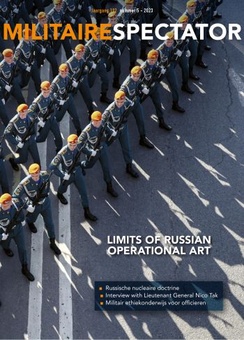1 German-Netherlands Corps (1GNC) is the Land Component Command HQ of the NATO Response Force (NRF), the Alliance’s rapid reaction force, in 2023. What does it take for a headquarters to fulfil this role? And what are the challenges lying ahead for the NRF against the backdrop of the war in Ukraine? Lieutenant General Nico Tak, Commander of 1GNC and NRF land forces, spoke about these issues with the Militaire Spectator. ‘Scale, mass, and size matter again’, he says. ‘War in Europe cannot be prevented with battalion-sized units, the continent cannot be kept safe that way.’
Han Bouwmeester and Maarten Katsman
The NRF was founded in 2002 with the overarching purpose of being able to provide a rapid military response, including collective defence purposes and other crisis-response operations, to an imminent crisis. The joint response force is based on an annual rotation system for which NATO allies provide land, air, maritime and/or special operations forces for a period of twelve months. NATO states: ‘As units rotate through the NRF, the associated high standards, concepts and technologies are gradually spread throughout the Alliance, thereby fulfilling one of the key purposes of the NATO Response Force – the further transformation of Allied forces.’[1]
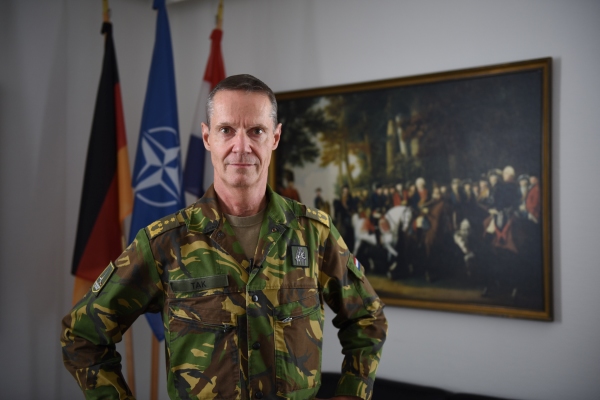
Lieutenant General Nico Tak, Commander 1GNC and NRF Land Component. Photo 1GNC
Certification
Raising and meeting high standards also applies to the HQ that commands (components of) the NRF. Before assuming command, an HQ must be declared ‘combat ready.’ Exercises Steadfast Cobalt and Steadfast Jupiter 2022 were 1GNC’s preparatory exercises for the NRF. Steadfast Cobalt specifically aimed at interoperability of C4ISR (Command, Control, Communications, Computers, Intelligence, Surveillance, and Reconnaissance). Steadfast Jupiter, on the other hand, exercised the execution of operations. Lt Gen Tak: ‘The multinational character of the NRF and related exercises bring out the best in the staffs. When working together with personnel from all those allies, you really don’t want to drop the ball.’ Steadfast Jupiter was the certification exercise in Stavanger, and during 1GNC’s year of command the HQ participates in several larger and smaller exercises to keep its capabilities at the desired level on all fronts.
‘Our notice to move is an important factor for the NRF. At the moment we deploy to Sardinia (this was scheduled some time in advance, ed.). Deployment includes a spearhead battalion, an initial command element and most of the communications units. This latter part is intentionally “oversized”, because I want to prove that we can get all the command & control elements in place within the required timeframe.’
Lt Gen Tak emphatically tweaked the exercises for 1GNC as the NRF’s Land Component: ‘NATO in general is a champion in making plans, but we need to switch to warfighting again. It was my intention to create some challenges for the exercise, so I set four conditions for the scenarios. First, 1GNC would enter a conflict that was already well underway after the fighting erupted. Second, the enemy had already made some gains in the scenario and we had to figure out how to turn the tide and reclaim the initiative. Third, we had to operate without air superiority, and last, my focus was also on our rear area, to include that in our plans.’ This approach paid off, and Tak introduced some other adjustments as well: ‘We raised the ceiling for air operations by land forces (missile artillery, helicopters, ed.) to more than 20,000 feet. That way, air forces have to request permission before using the air space for their operations, instead of the other way around. This approach dramatically decreased targeting times from hours to mere minutes. When enemy units move and reveal themselves, they will be taken out almost immediately by coordinated artillery, helicopters and fast close air support. This only works, however, when we as the Land Component become trusted partners of NATO’s Air Component and that requires a lot of time and exercises, but both the Land and Air Component will improve as a result.’
‘NRF as a strategic reserve force’
The overall command of the NRF falls under NATO’s SACEUR, the Supreme Allied Commander Europe, a post currently filled by U.S. Army General Christopher Cavoli. Operational command of the NRF alternates every year between the Allied Joint Force Commands in Brunssum, the Netherlands, and Naples, Italy. This year it is Italy’s turn, so Lieutenant General Tak reports to JFC Naples’ Commander Admiral Stuart Munch (U.S. Navy).
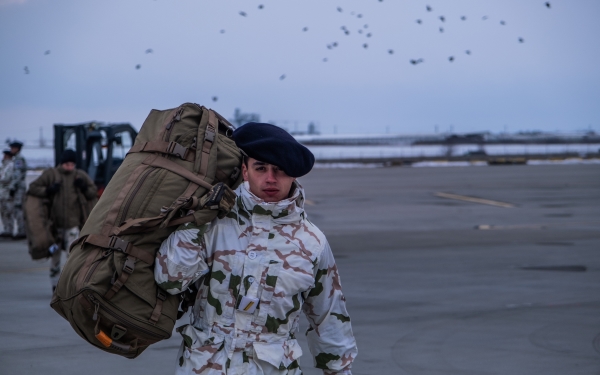
French NRF Forces deployed to Romania in 2022. It was the first time in its history the NRF had been activated for defensive purposes. Readiness and a short notice to move are key in the NRF’s deterrence value. Photo NATO
From the 1990s onwards, NATO’s core task of collective defence was pushed to the background. For example, the NRF (or elements thereof) as ‘first responder to any emergency’ was deployed to assist in protecting the 2004 Summer Olympics in Athens, Greece, and to support the Afghan presidential elections in September of that same year. The NRF has also been used in disaster relief, including in assisting the US in the aftermath of hurricane Katrina in 2005.
Russia’s invasion of Ukraine is a geo-political game changer. After the illegal annexation of Crimea in 2014, NATO already reacted by ‘enhancing’ the NRF and by setting up a Very High Readiness Joint Task Force (VJTF), ready to move within three to five days. Then, in February 2022, high-readiness elements of the NRF were deployed for the first time in a deterrence and defence role following Russia’s full-scale assault on Ukraine. Tak: ‘The NRF currently functions as a kind of strategic reserve for SACEUR. Individual nations contribute units to strengthen NATO’s eastern flank, which is a good thing, but the NRF can do so much more and provides more options.’ Especially the Land Component of the response force makes a difference, according to Tak: ‘Land units can physically control an area. That makes a real statement to any potential adversary.’
The enhanced NRF consists of three layers. The above-mentioned VJTF, with a two-day notice to move, is technically a brigade ‘plus’. However, ‘in practice it is more like a division, because at the moment it comprises 14,000 personnel’, Tak explains. After the VJTF has deployed, it can be reinforced by the Initial Follow-On Forces Group (IFFG), jointly formed by two multinational brigades. Both the VJTF and IFFG units are stationed in their home countries. ‘The IFFG units are the VJTF stand-up and stand-down units’, Tak clarifies, ‘so they are the units training for their VJTF rotation in the next year and the ones that have just finished their rotation, respectively.’ Tak continues: ‘The reaction time of the IFFG used to be 30 days for one brigade and 45 for the other, but that has been reduced for both.’ The third layer are the Follow-On Forces, which have to be ‘force-generated, as soon as the responsible nations can provide them.’ Tak insists that ‘these are significant units, like HIMARS battalions (mobile rocket artillery, ed.) and aviation brigades.’
In Tak’s view, readiness is key here, and, ‘SACEUR has the ability to increase the readiness level, the notice to move, for all three layers. Especially when the third layer follows the first two in a shorter timeframe, SACEUR can bring a really significant force to the field.’
‘Scale, scale, scale’
Increasing interoperability between NATO allies is one of the key tasks of the NRF. However, ‘because we have had a long period of out-of-area operations and wars of choice, there was no need to operate in large-scale units, let alone in multinational ones. This has had a detrimental effect on interoperability compared to the situation in the 1980s when the Cold War was still ongoing’, according to Tak. Now, he says, there is a movement back to ‘NATO-assigned or dedicated forces. NATO’s Regional Plans will be the most important means to defend Europe. Who does what and where, and with what kind of assets? When we bring that connection back between threats, plans, and the required assets, interoperability will automatically get a boost. In fact, in the case of Germany and the Netherlands we may arrive at a situation of interchangeability, where both countries will procure the same equipment.’
Tak refers to SACEUR General Cavoli, who earlier this year in Sweden stressed the significance of NATO’s updated Regional Plans as well. In his speech, Cavoli also alluded to the implications of the war in Ukraine for the type of militaries NATO countries need. One of the most important factors to take into account is, according to Cavoli, ‘Scale. Scale, scale, scale, scale. The magnitude of this war is incredible. The Ukrainians have 37 front line brigades, 37. Plus dozens more territorial brigades. The Russians have lost almost 2,000 tanks, the Russians alone 2,000 tanks, lost (…). The scale of this war is out of proportion with all of our recent thinking but it is real and we must contend with it.’[2]
‘Size matters again’, adds Tak. The deterrence role of the NRF becomes apparent in this regard: ‘War in Europe cannot be prevented with battalion-sized units and the continent simply cannot be kept safe that way. SACEUR plans with army corps. Wars often last longer than anticipated, so it is not just a question of having enough initial forces. Regeneration is a very important factor’, says Tak, ‘not only when a war has already started, but also before it has.’ The ability to regenerate becomes a factor for credible deterrence, and this is something NATO’s new member Finland excels in. Tak: ‘When, like the Fins and the Norwegians, you are able to continuously increase your force generation, to be able to scale up, to create a total defence mindset as a society, it becomes less and less attractive for an opponent to try a land grab. It will simply cost too much.’
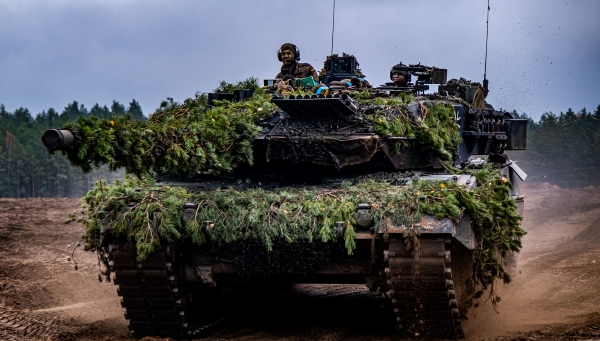
A German Leopard 2 tank exercises in Lithuania. In armed conflicts, ‘size matters again’. Photo NATO
Whereas Norway and Finland have highly resilient societies, this is not necessarily the case for all members of the Alliance. In the case of the Netherlands, resilience is not a foreign concept, but Dutch society has to embrace this concept again because the stakes are high, argues Tak. ‘The Netherlands is one of the most important gateways to Europe, also for military logistics. It doesn’t take rocket science to conclude that Dutch infrastructure and institutions are high on the target list if and when a wider war breaks out. We must be prepared for such a contingency.’ History provides some valuable lessons because during the Cold War there were several initiatives in the Netherlands that would improve resilience in case of war. ‘Military representatives were placed at train stations, to ensure optimal military movement’, explains Tak. ‘Requisition of civilian materiel was well-regulated. Emergency bridges were available to enable allied forces to cross important rivers. Designated units were in place to aid and support civilians. We could draw on that experience to rediscover what is needed.’ Recently the Dutch government has published a new security strategy, and ‘that is a good starting point’, says Tak, because ‘it integrates domestic and foreign security. They are related and cannot be addressed separately. It also shows that the security establishment is on the right path, but there is still a long way to go.’
Overall, ‘warfighting’ and ‘winning wars’ must return to the vocabulary across the Atlantic Alliance. Tak: ‘With the wars of choice of recent decades the concept of winning a war has changed. The bulk of Western military personnel is not used to large-scale conflicts anymore. But when the bullets start flying around, regular soldiers are the first to realize what it means to win or lose in a full-scale war. They might have to pay the highest price. Survival on the battlefield is not enough, we need to win! That mindset, that we have a way of life that is worth fighting for, must also be adopted by society as a whole, at all decision-making levels.’
A failure in deterrence?
As stated above, the NRF has been deployed for deterrence purposes for the very first time in its twenty-year existence after Russia’s invasion in February 2022. What went wrong with NATO’s deterrence posture vis-à-vis Russia? Do the opposing sides still understand each other’s signals? ‘Western collective deterrence failed during and after Russia’s 2014 annexation of Crimea’, states Tak. ‘From a Russian viewpoint, that was a successful military intervention. Then, in 2015, its military intervention in Syria also generated favourable results for Russia. Syrian President Assad was widely expected to be ousted, but the Russian military secured his position. Again, from a Russian perspective the military instrument of power was used successfully.’
Despite a forceful American and British response to Crimea, the West appeared weak in Russian eyes. ‘And to the Russian elite’, says Tak, ‘weakness is an invitation, or even a provocation, to be exploited. As opposed to the Western way of cooperation and trying to find common ground, they reason within a zero-sum framework. The Russian reality is far removed from our values.’
There are some obstacles conceivable with regard to deterrence and the NRF. NATO currently counts 31 members and the NRF can only be deployed when all those 31 allies have reached consensus. What is general Tak’s experience with this political dimension? ‘Actually, the North Atlantic Council, NATO’s political governing body, responded surprisingly quickly that morning in February 2022. Within a few hours, they had reached consensus about its response. That kind of cohesion may have been unexpected at that moment, but it persists to this day.’
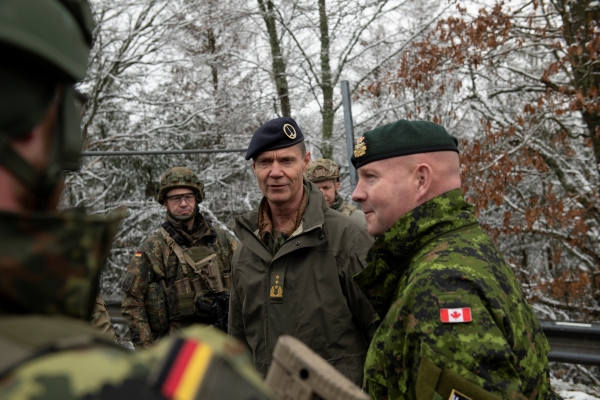
Lieutenant General Tak and 1GNC's Operational Liaison Reconnaissance Team prepare for NRF exercise Noble Jump. Photo 1GNC
Another challenge for deployment of the NRF could be the national barriers regarding military movement through Europe. After all, when the Land Component is activated, many units and their equipment must be transported from their home countries to the conflict theatre. Again, however, the war in Ukraine was a catalyst for a swift response. ‘When you look at the amount and kind of equipment that has been moved from West to East’, explains Tak, ‘it becomes obvious that bureaucratic limitations can quickly be overcome in times of crisis.’ Still, when faced with large-scale movements when the NRF has been activated, challenges remain. Therefore ‘We should practise this logistical process, including working with host nations. NATO is slowly working on exercises on scale, and those will come at some costs. It is the price of doing business, so to speak.’
Finally, Lieutenant General Tak also makes it clear that in its role as the NRF Land Component, HQ 1GNC is not only looking at a possible Russian scenario. ‘A lot is happening at the borders of the NATO area, which is why we also follow developments in the Balkans, North Africa and the Middle East. NATO must remain vigilant and deter as credibly as possible to prevent conflicts from spilling over into our territory. 1GNC, the German and the Dutch armed forces contribute strongly to this, and we can all be proud of that!’
[2] NATO SACEUR Cavoli, ‘Remarks at Rikskonferensen, Sälen, Sweden’, 9 January 2023.
